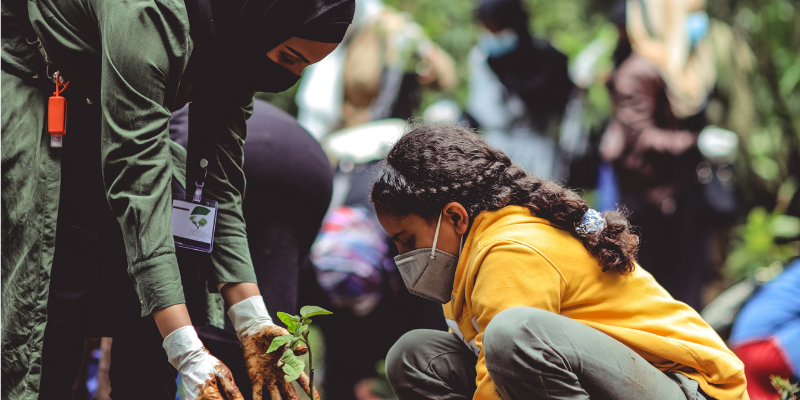
What the latest IPCC report means for people and communities


.@CPI_foundation's @chandrima_lp believes we need ambitious #climateaction that is structured in a way to ensure the transition to a net-zero world is inclusive, place-based, and sustainable.
Share article"It is important to acknowledge and design for the fact that people’s lived realities, priorities, and socio-economic capacities are constantly changing." @CPI_foundation's @chandrima_lp
Share articleHow can local governments engage the public on climate change? 🌏 @chandrima_lp suggests adopting these four principles around public engagement.
Share articleWe put our vision for government into practice through learning partner projects that align with our values and help reimagine government so that it works for everyone.
The problem: We need ambitious climate action that is structured in a way to ensure the transition to a net-zero world is inclusive, place-based, and sustainable.
Why it matters: The conditions of climate change have far-reaching impacts on people’s quality of life, and often disproportionately affect vulnerable and marginalised groups.
The solution: Local governments can engage with the public on climate change more meaningfully by adopting these four principles around public engagement.

This week, world leaders will gather at COP26 to negotiate a ratcheting up of ambition from the commitments made by countries as part of the Paris Agreement in 2015. Meeting these commitments will involve deep-seated transitions in economies, institutions, governance, politics, and societies. These changes will drastically impact people’s lives and involve significant trade-offs that touch on public values.
So, while much of the attention at COP26 will (rightly) be focussed on ‘what’ countries will commit to, we believe there is an urgent need to also focus on ‘how’ these commitments will be delivered so that they are inclusive, place-based and sustainable over the long-term.
Public engagement is a critical component in building a collective public mandate for climate action.
At the Centre for Public Impact, we believe that achieving this requires placing individuals and communities at the heart of shaping a place-based transition to net-zero. Public engagement is a critical component in building a collective public mandate for climate action. It brings with it the opportunity to create a better, and more inclusive future - one in which individuals and communities are actively involved in shaping the policies and decisions that affect them.
Through our work, we’ve seen that engagement with communities is most effectively facilitated at the local level by city governments and councils. Despite the challenges that COVID-19 has thrust on local government, the last year has seen rapid experimentation and learning in local places. And as we take on increasingly complex challenges like climate change, it is important that people and communities are placed at the heart of this learning journey. So here are our four key takeaways for how local governments can engage the public meaningfully on climate change, and deliver on our ambitious climate commitments:
The biggest challenge to effective public engagement is when it’s shaped to inform and ‘educate’ communities, and is essentially one-directional. These framings prevent local government from building a deeper understanding of people and place and the emergent relationships between them, particularly in the context of evolving climate impacts.
However, framing public engagement as a two-way learning process from the outset creates the institutional permission space for local governments to take a step back and learn with and from communities. This means meeting communities where they are, amplifying diverse voices, and fostering authentic learning around community values, identities and experiences - and how that impacts choice, risks, costs and the priorities of different groups. In turn, this can more effectively inform climate-related decision-making, resource allocation and commissioning.
People and communities don’t experience the world as disjointed policy spheres and issues – their priorities cut across institutional boundaries and levels. However, public engagement opportunities can be fragmented and siloed, channelled through separate institutions, each with a limited remit to respond comprehensively.
We need a more joined-up and coordinated approach to local governance that can make space for complex public input. We also need tools and processes that enable us to discuss how local decisions aggregate benefits and risks at a systems level. Doing this effectively will require partnering, collaborating, and supporting the work of other teams, departments, ministries and actors that are working with communities in different ways to embed public engagement more systemically in local governance.
People and communities don’t experience the world as disjointed policy spheres and issues – their priorities cut across institutional boundaries and levels.
Public engagement is commonly associated with formal institutional processes set out at key decision-making points. However, legitimate decision-making requires sustained, iterative dialogue with regular feedback from people and communities over the longer term.
It is important to acknowledge and design for the fact that people’s lived realities, priorities, and socio-economic capacities are constantly changing. As such, no recommendation that comes out of a participatory process can be an end in itself - it should be seen as the start to an ongoing and iterative dialogue. To support this, without the risk of consultation fatigue, would require local governments to create spaces for more continuous, informal, relational forms of public engagement that also improve community relationships and trust.
It is important to keep the following questions in mind when thinking about inclusion.
Where is the engagement taking place?
Who is taking part in them, who is not, and why?
Who is being best served by the outcomes of this process, and is this equitable?
For example, when delivering a citizen assembly process, it is important to question whether the recommendations coming out of the assembly process serve one group of people over another. This question is particularly important as although diversity in terms of participant representation might be designed into the process of engagement, it could still be the loudest group in the room that is being heard.
Countering this requires a focus on the quality of deliberations, the capacity of all groups to participate, the language being spoken and the tools being used. It also requires a consideration of structural conditions such as formal and informal power relations which shape people’s ability to participate in, and benefit fairly from, decision-making processes, policy and interventions.
Climate change is one of the most pressing and urgent challenges that we face today. And as we build on the commitments and actions from COP26, local governments play a vital role in ensuring the transition to net-zero is just, equitable and regenerative for people and the planet. We hope the lessons, principles and considerations that we’ve outlined above can support local governments to engage with local communities and respond to climate change together.
---
At COP26, we will be working to make the case for putting people and communities at the heart of climate action as we deliver on ambitious climate commitments. If you’re interested in getting involved, or want to know more, get in touch.
